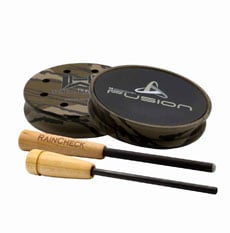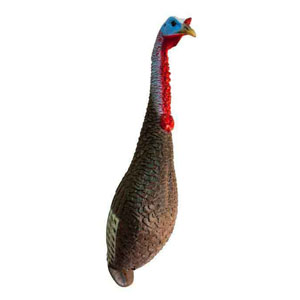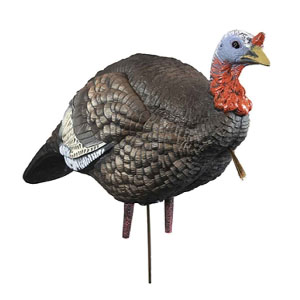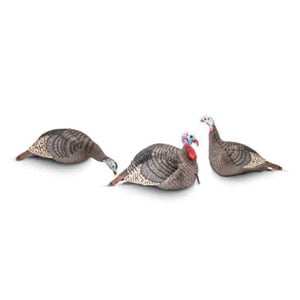Bowhunting Wild Turkeys 101:A Beginner's Guide
By Dan Young |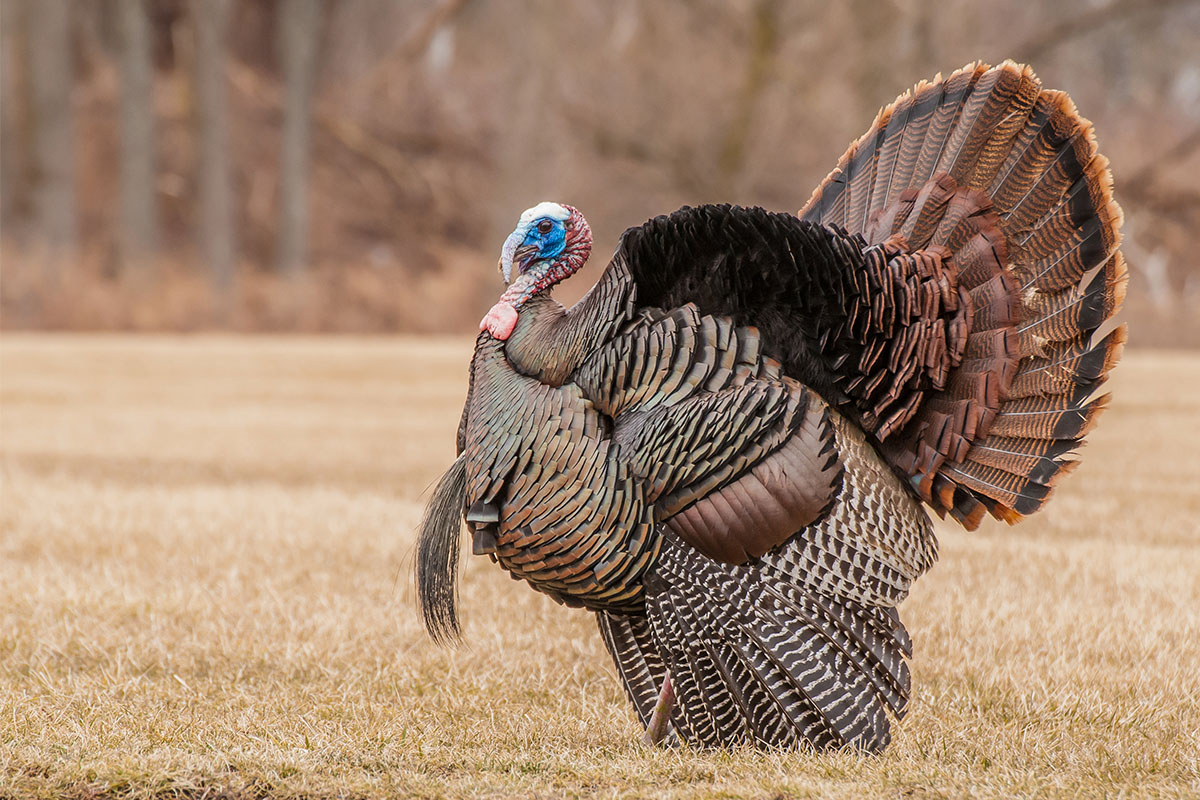
Hunting Wild Turkeys with a bow and arrow can be one of the most exciting and most difficult challenges a hunter can face. However, because of the challenge, it can also be one of the most rewarding experiences a hunter can have. In fact, most turkey hunters will agree that calling to a big Tom and hearing him answer in the distance and then patiently waiting while watching him approach your decoy provides a thrill that is unlike any other in the hunting world.
But, learning to bowhunt wild turkeys can be somewhat intimidating to a novice hunter since there is so much to learn. Therefore, below you will find a beginner's guide to bowhunting wild turkeys that will teach you the basics of how to locate them and how to call them as well as other important aspects of the art of bowhunting turkeys.
Locating Wild Turkeys
A successful turkey hunt is entirely dependent on scouting and, scouting best done prior to the opening of turkey season. Thus, if you are a novice turkey hunter, then it is imperative that you learn how to recognize and scout turkey habitat because, a few days spent scouting prior to the opening of the season will maximize your chances of harvesting a big Tom or a Jake when the season does open.
So, what should you look for when scouting turkey habitat? Well, the trick to finding wild turkeys is similar to that of finding whitetail deer in that you need to find their favorite feeding locations, their strut zones, and their roosts.
Thus, you need to be aware that turkeys like to inhabit and feed in a wide variety of habits ranging from dense hardwood forests to open woodlands to grassy fields. They also like to feed on a wide variety of foods such as acorns, hickory nuts, and beechnuts, fruits such as black berries, wild strawberries, and muscadines, large insects such as grasshoppers, crickets, and caterpillars, invertebrates such as snails, slugs, and earthworms and, small reptiles such as lizards and small snakes. Consequently, wild turkeys can often be seen feeding in fields alongside cattle because the cattle stir up insects, lizards, and small snakes that the turkeys like to eat.
Locating Feeding Areas and Strutting Zones
However, locating a feeding flock of wild turkeys in the woods can be tricky even with a locator call. Thus, a better method for novice turkey hunters is to use your vehicle to ride the roads adjacent to or through the area where you intend to hunt and take note of any flocks that you see feeding out in the open since this will provide you with a definitive starting point. Then, once you have located some of their favorite feeding areas, you can then use one of three different methods to locate both their favorite strutting zones and their favorite roosts.
So, because strutting zones are prime locations for setting up your blind, the next step is to locate one or more of them. But, what is a "strutting zone" you may ask? Well, a strutting zone is a favorite location where a mature male turkey (known as a "Tom") feels safe and likes to gobble and strut to display his fitness as a mate for the female turkeys (known as "Hens") in the area. Consequently, Toms always choose locations where they have a large, 360 degree, field of view and room to fly away if threatened by a predator. Therefore, they can range from a small clearing in the woods to a saddle between two hills to an elevated position in an open field.
So, in order to locate a strutting zone, you should first return to one of the locations where you have previously seen turkeys feeding. If the area is a large, open, field or, series of fields, then you should look to see if there are turkeys feeding there again and, if not, then carefully observe the area to see if you see a lone Tom holding in a particular location who may or may not be accompanied by Hens. However, if there are turkeys feeding there, then you should observe them, note their direction of travel, and follow them at a distance because doing so will likely lead you to either a strutting zone or a favorite roost.
On the other hand, if the feeding area is something like a small field or clearing adjacent to woodlands but there are no turkeys presently feeding there, then you should quietly enter the woods adjacent to the feeding area. Then, once you are into the woods a ways, you should make a few calls using a locator call such as a hawk or crow call because this will often elicit a response call from a Tom or a Jake (an immature male). Then, if you do get a response call, you should note the direction from which it comes.
Next, you should slowly move in the direction from which you heard the turkey answer your call while stopping periodically to call again and listen for a response. Then, once you are close to the location of the response, you should cease calling and carefully proceed to look for a clearing in the trees. Then, once you find a clearing, you should approach it quietly even though the turkey who answered your call will likely be long gone by the time you arrive, and then look to see if the leaf litter has been flattened or scraped clear and, if the earth is bare, you should look for turkey tracks. Consequently, if you find a clearing like this, then you have found a strutting zone and, once you have the location of one or more strutting zones, you should make a note of their location by designating them as a waypoints on a GPS unit so that you can easily find them again.
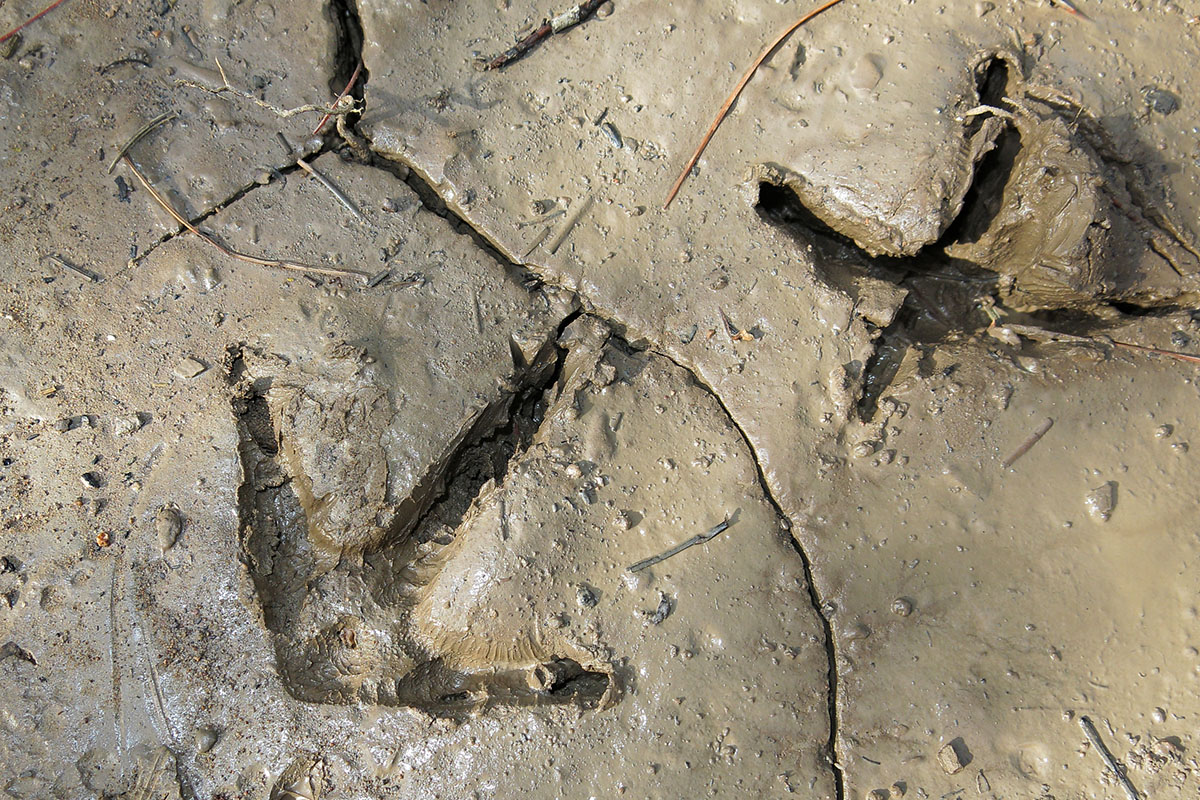
So, by finding and noting the location of one or more feeding areas and strutting zones prior to the opening of the season, you will know exactly where to set up your blind when the season opens and thus, maximize your chances of harvesting a big Gobbler.
Locating Roosts
Finding favorite roosting trees is done in a similar manner to finding strutting zones in the woods in that it also involves the use of a locator call. However, instead of scouting the woods in the day time while using a crow or hawk call, the best way to find a favorite roost is to enter the same woods a couple of hours before dawn and call with an owl call instead. This too will often elicit a conditioned response call from a Tom or a Jake and thus, you can then follow the direction of the response call while using your owl call occasionally to pinpoint the location of the particular tree in which they are roosting for the night. However, once you find it, it is important not to approach their roost too closely since you don't want to disturb them.
Then, once you have located their favorite feeding areas, their favorite strutting zones, and their favorite roosting trees, you will have a pretty good idea of what direction the turkeys will travel in when they come down from their roost in the morning. This information, in turn, will enable you to choose a prime location to set up your blind and your decoy or decoys in order to have the best chance and calling a Tom or a Jake within range of your bow.
Turkey Blinds
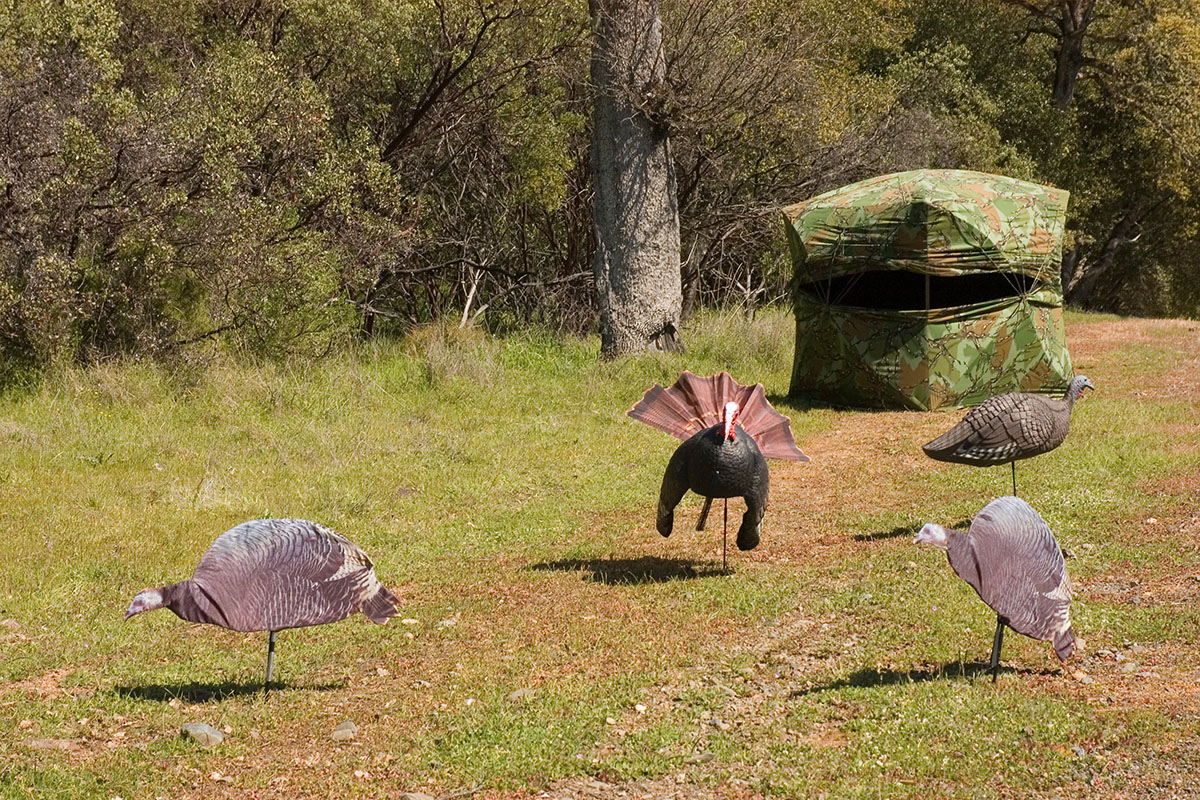
But, you should also be aware that a turkey's eyesight is particularly acute and they are exceptionally adept at noticing movement. Also, because every animal from foxes and coyotes to owls and eagles likes to eat them, turkeys are extremely paranoid. Therefore, they are easily spooked by even the slightest movement and thus, you absolutely must have a blind when hunting turkeys with a bow.
However, although there are many different types of blinds ranging from fully enclosed tent blinds to those as simple as a length of dyed burlap suspended on a series of poles, the main objective of a blind is to provide you with enough cover that you will not be seen when you raise and draw your bow. But, you must also place your blind in the proper position because you want the turkey or turkeys to approach your decoy, and thus your blind, from the front rather than from the side or the back.
Therefore, by knowing the location of their roost as well as the location of their favorite feeding areas and, by knowing that turkeys most often move to their feeding grounds immediately after coming down from their roost at dawn, you can position your blind directly in their most likely path. Then, you can place your decoy between their roost and your blind so that they will be most likely to approach in front of you.
On the other hand, Toms and Jakes often retreat to strutting zones after feeding in the morning and thus, strutting zones are best hunted later in the day rather than at dawn like roosts. So, in order to hunt strutting zones, you need to be in your blind before the turkeys arrive. Then, you will need to wait until they decide to make an appearance and then draw them into your decoy by using a turkey call.
Turkey Calls
Of course, learning to call turkeys is an integral part of the turkey hunting experience and some hunters spend years perfecting this art. Thus, you should be aware that there are three common types of turkey calls consisting mouth calls, slate calls, and box calls and each type of call can imitate a wide variety of turkey sounds.
However, most novice turkey hunters find box calls to be the easiest type of turkey call to use since they consist of a long, hollow, wooden box with a sliding wooden lid or bottom and are capable of making many different types of turkey calls such as clucks, cuts, purrs, and yelps as well as both cackles and gobbles. But, they are more bulky, and thus more cumbersome to carry, than a slate call.
Slate calls (aka "pot calls") on the other hand are small, round, discs designed to be held in your hand and are made from a wide variety of materials such as slate, crystal, copper, aluminum, titanium, and Plexiglas. In addition, they are accompanied by a device called a "striker" which is commonly made from wood, carbon, or plastic and which is used to rub the surface of the disc while varying the amount of pressure applied to create the different types of calls. Therefore, slate calls are capable of imitating a wider variety of turkey calls than a box call is while also being relatively easy to learn to use.
Last, there are mouth calls which, as the name implies, consist of one or more thin latex diaphragms known as a "reeds" surrounded by a rigid plastic frame that you place against the roof of your mouth. This, in turn, leaves your hands free to raise and draw your bow while calling. However, mouth calls are not capable of creating the wide range of calls that box calls and slate calls can and thus, they are limited to rasps, raspy cuts, soft yelps, tree yelps, kee kees, and whistles. Consequently, most bowhunters prefer to use either box calls or slate calls to draw Toms or Jakes in close their decoys and then, they switch to a mouth call when raising and drawing their bow.
A Few of Our Favorite Calls
Calling Wild Turkeys
Like turkey calls, turkeys also make a wide variety of sounds ranging from assembly calls to gobbles, clucks, purrs, clucks & purrs, putts, cutts, plain yelps, excited yelps, tree calls, and fly down or fly up cackles. Thus, experienced turkey hunters learn to make a wide assortment of calls as well. However, while learning how and when to call turkeys can certainly be a fascinating off season pursuit, it can also be a bit intimidating for novice turkey hunters. Fortunately, hunters who are just beginning to learn how to hunt wild turkeys can focus their efforts on learning just three simple calls.
Locator Calls Calls - The first call is called a "locator call" and it is a call that imitates the calls of animals such as owls, crows, woodpeckers, and hawks. Therefore, because mature Toms perceive these calls as a challenge to their dominance, you can use locator calls to find them. So, all you have to do is make a few calls on your locator call and you can almost always elicit a conditioned response from any Tom or Toms in the area. Also, by noting the direction that the response call is coming from and how far away it is, you can plan where to set up your decoy and your blind. Last, although owl calls are primarily used at night, they will work in the day time as well. But, both hawk and crow calls are probably a better choice for day time use.
Yelps- The next type of call you need to learn to make is called a "yelp" since adult female turkeys use this call as an assembly call as well as to attract mature Toms for mating. Therefore, this call consists of a series of 9 to 12 short, high-pitched, two-note sounds and it can be made with either a box call or a slate call. Consequently, a yelp call can be use to inform other turkeys in the area that you are there and to invite them to come and join you or, it can be used to entice a mature Tom to come in and investigate your hen decoy in order to draw him within bow range.
Clucks- Last, there is the cluck which is a sound that hens make along with putts and purrs when they are feeding and when they are content and thus, its purpose is to convey to other turkeys that everything is all right. Consequently, clucks can be used to soothe and calm recalcitrant Toms and make them decide to approach your decoy and, unlike yelping, it's difficult to cluck to often provided that you keep your clucks both soft and subtle.
Thus, clucks are a good call to use anytime you hear or see a turkey. However, they are most effective when inserted randomly between a series of yelps to let any turkeys in the area know that a hen or flock of hens is nearby and that they are safe, comfortable, and relaxed and that any turkeys nearby are welcome to join them.
Last, five important tips that will make you a more effective turkey caller are to practice often, vary your calls, don't call too often, don't call too loud, and know when to stop calling.
Turkey Decoys
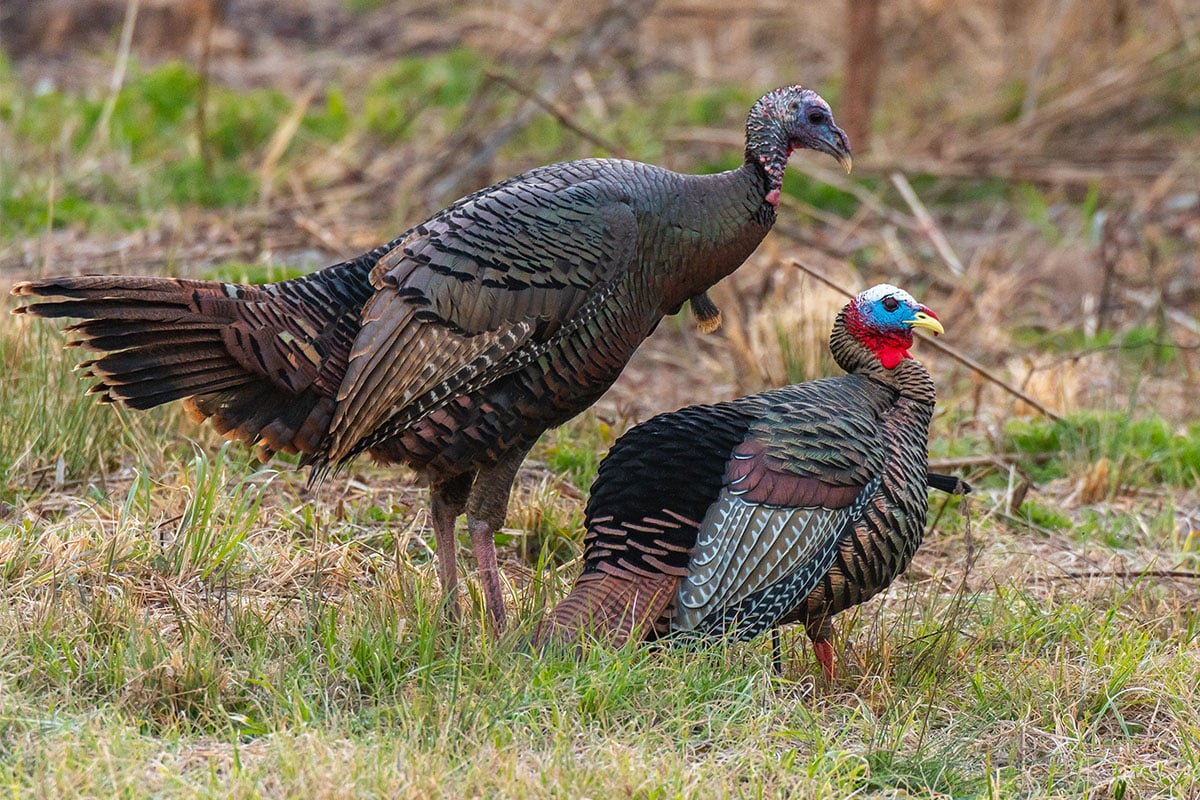
Of course, if a mature Tom does decide to come in to your calls, then he is going to expect to see a hen or a flock of hens when he arrives and, if he doesn't, then it's going to set his alarm bells off and cause him to hightail it out of there. Therefore, in addition to one or more turkey calls, you will also need one or more turkey decoys. However, note that turkey decoys range from those that are highly detailed with perfect coloring to those that depend more on imitating the general shape and color of a turkey and, they are priced accordingly.
Furthermore, they all have advantages and disadvantages over the others. For instance, the expensive, highly detailed, turkey decoys are usually made from a rigid plastic and thus, they are bulky and difficult to carry. However, collapsible or folding decoys are on the other end of the scale in that they are often not highly detailed but, because they are made from a soft, light weight, foam rubber, they are easy to carry because you can fold them up and place them in a day pack or a pocket of your turkey vest which makes it relatively easy to carry and set-up multiple decoys. So, choosing a turkey decoy is more a matter of personal choice than it is methodology.
However, the most commonly used type of turkey decoy is the Gobbler which looks like a large, mature, strutting male turkey. By using this type of decoy, you will present a challenge for dominance to any mature Tom that comes close enough to see your decoy which will present an irresistible challenge that simply cannot be ignored. In addition, note that single Tom decoys can be accompanied by one or more Hen decoys to make the scene even more realistic.
Another favorite way to deploy turkey decoys is to combine a series of 3 to 5 Hen decoys with a single Jake decoy while placing one of the hen decoys on the ground in a relaxed posture and the others in a feeding posture with the Jake in an alert posture in order to cause any Tom that may approach to feel safe and at ease rather than ready to fight.
Last, you should be aware that mature male turkeys are only interested in one thing when approaching hens and thus, they are only interested in the back side of the hen. Therefore, it's a wise idea to place your hen decoys so that they are facing away from you rather than toward you. That way, any Tom that decides to approach your hen decoys will be forced to circle around to approach them from behind and thus, turn his back to you. Plus, the same is true of Jake decoys except, in the case of Jakes, you want to position the decoy so that it is facing you rather than facing away from you so that you will again force the approaching Tom to circle around and turn his back to you when he confronts the jake decoy beak to beak.
So, why is it best to position a Tom or Jake with his back to you when bowhunting? Well, the answer to that question is that turkeys have exceptionally sharp eyesight and they are hyper observant. Thus, they will often see even the slightest movement which often causes them to spook. So, even though you may have a well camouflaged blind and, even with a Tom's attention focused on your decoy, the odds are high that he will still see you as you raise and draw your bow unless his back is turned toward you.
Therefore, that leads to the question of how far from your blind should you set your decoy or decoys? Well, the short answer to that question is no less than 10 yards and no more than 30 yards but, the true answer is dependent on how well you can shoot.
For instance, the closer to your blind you set your decoy, the larger your target will be and thus, the easier it will be to hit. But, at the same time, the closer a turkey is to your blind, the more likely it is that he will see you as you raise and draw your bow. On the other hand, the farther away from your blind your decoy is, the less likely it is that a turkey will see you when you raise and draw your bow. But, at the same time, your target will be smaller and thus, more difficult to hit. So, the better you can shoot, the farther away you can place your decoy.
Therefore, the correct answer to the question of how far from your blind you should place your decoy is that you want to place your decoy as close to your blind as you can without spooking the turkey when you raise and draw your bow so that you will have the largest target possible. However, exactly what the perfect distance is depends on the turkey, the terrain, and the hunter.
A Few of Our Favorite Decoys
Turkey Anatomy and Shot Placement
Yet another key factor to successfully bowhunting turkeys is to understand their anatomy as well as proper shot placement. Thus, novice bowhunters should be aware that lethal hits can be scored on turkeys regardless of whether they are facing you, facing away from you or, broadside to you.
Frontal shots - Shooting a turkey while it is facing you is one of the most difficult shots because the turkey is most likely to see you raise and draw your bow. Therefore, this type of shot is best taken by hunters in fully enclosed tent blinds. However, if you do get this shot, then you should aim between the base of the neck and the spot where the beard sprouts from the chest on both relaxed and strutting birds which will cause your broadhead to slice through the lungs and may even sever the spine.
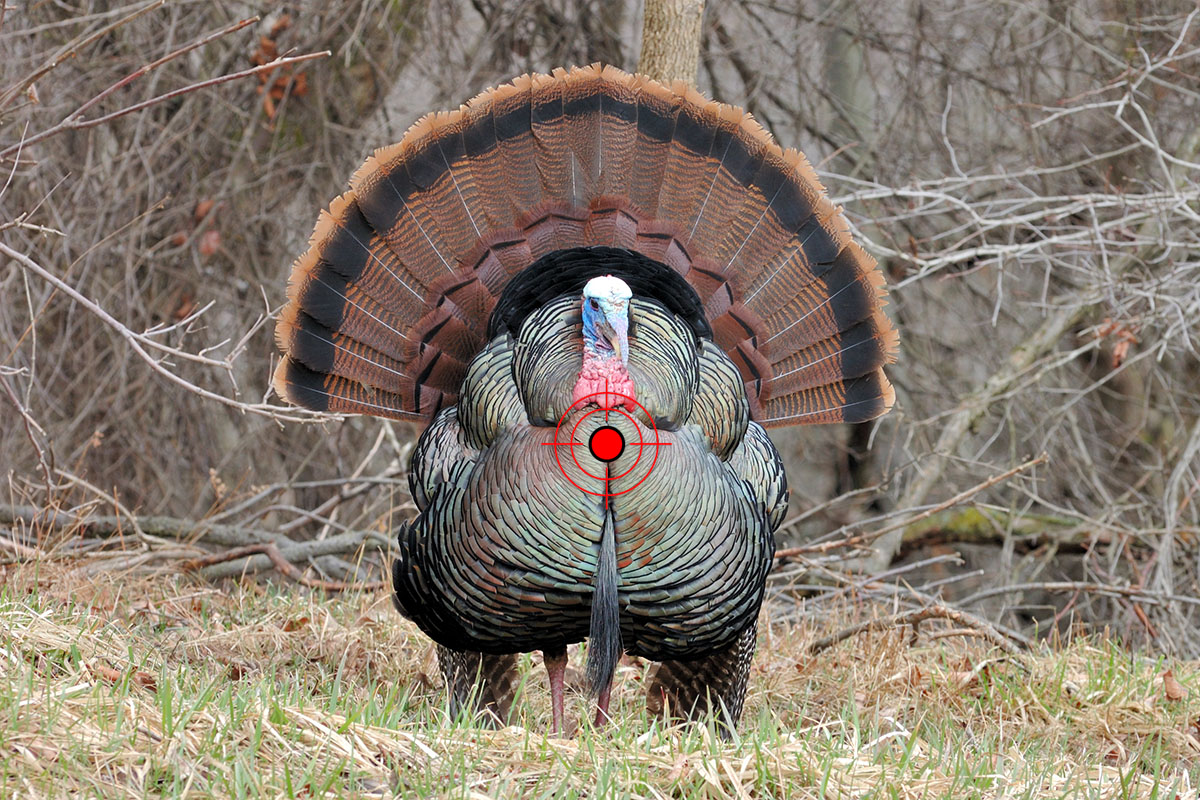
Broadside shots - Broadside shots on the other hand offer you a choice of aiming for the heart or the lungs. While the heart is the more lethal of the two shots and thus, it will dispatch the bird more quickly than a lung shot will, the heart is also a significantly smaller target and thus, it's easier to miss it. Hitting the lungs on the other hand will not dispatch the bird as quickly as a heart shot will but, the lungs present a much larger target than the heart and thus, they're easier to hit.
So, on turkeys that are strutting, aim at a point that is horizontal to the base of the neck and vertically in line between the forward edge of the barred wing feathers and the highest point of the back. But, for birds that are resting, you should aim for a point that is in line with the base of the beard and about an inch behind the front of the leading edge of the wing. Hitting this point will result in a perfect heart/lung shot and, if you are a bit high, then your arrow will still sever the spine.
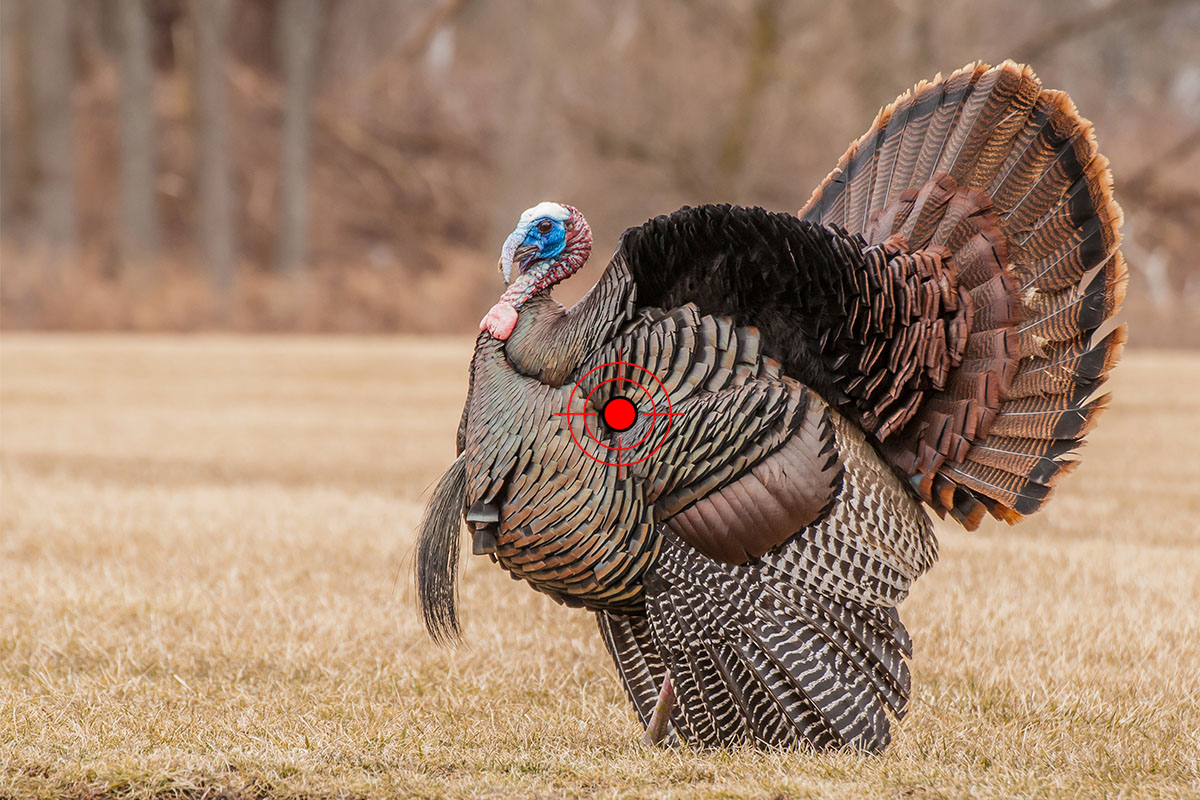
Facing away shots - This too is a deadly angle for shooting a turkey with an arrow because it exposes the spinal column to being severed by your broadhead as well as both the lungs and the heart. Thus, when shooting turkeys from behind, you should aim directly between the butts of their wings. But, when shooting strutting birds from behind, then you should aim directly at the center of the rectum which will position your arrow in line with the bottom of their lungs and the top of their heart.
Head and neck shots - Last but not least, both neck and head shots are positively deadly when bowhunting turkeys. However, they also present very small targets which are almost constantly moving and thus, they are the most difficult shots of all. However, some broadhead manufacturers do make so called "turkey guillotine" broadheads such as the Magnus Bullhead broadhead which has an exceptionally wide cutting radius of 2 3/4" or 3 3/4" depending on the model and these broadheads are specifically designed to decapitate a turkey. So, if you are going to shoot at a turkey's neck or head, then it's best to use a turkey guillotine broadhead.
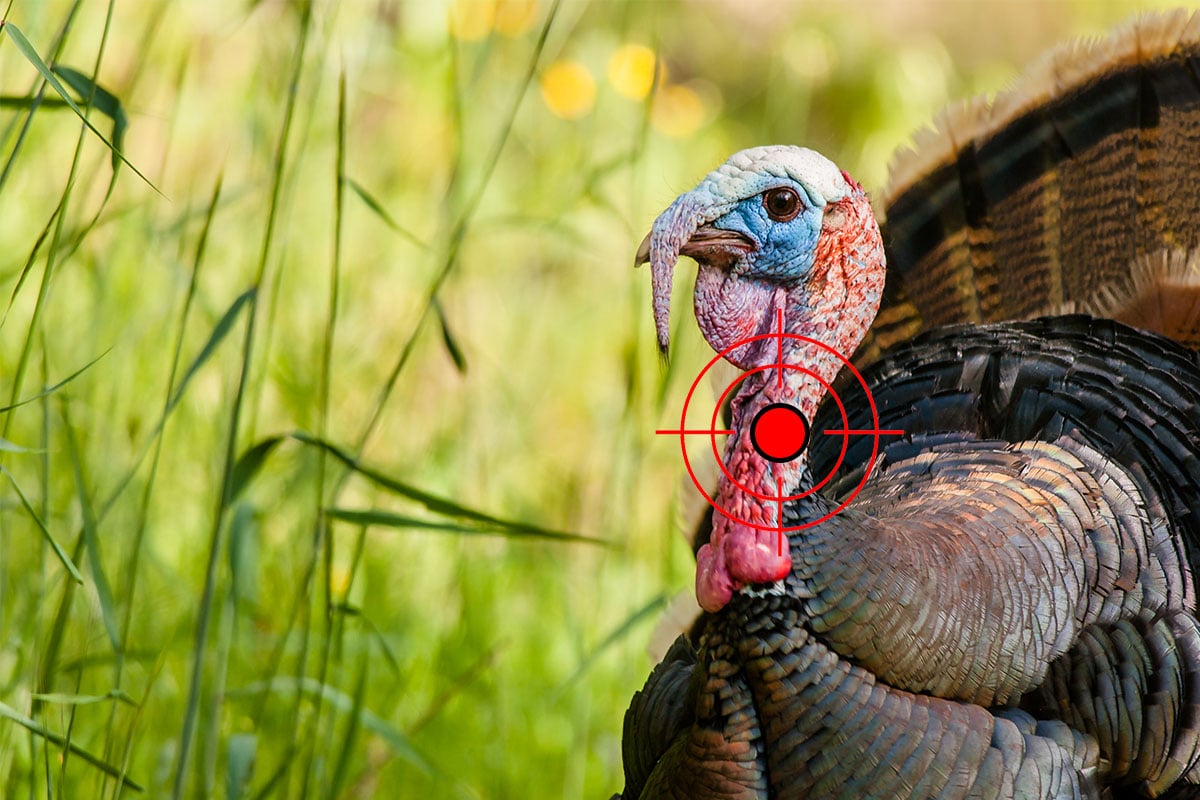
Bows and Broadheads
So, now we need to discuss both proper bow selection and proper broadhead selection. Therefore, the first thing to be aware of it is that although most bowhunters prefer to hunt turkeys with a compound bow, both recurve bows and long bows also work well. In addition, because turkeys are relatively small birds with fragile bones, you don't need a bow with a lot of draw weight. Thus, provided that your arrows and broadheads have sufficient inertia to fully penetrate the bird, you can get by with draw weights as light as 35 lbs. for recurve and longbows and 45 pounds for compound bows which conforms to the minimum draw weights for each type of bow in most eastern states.
In addition, you can use the same broadheads for hunting turkeys that you would normally use for hunting whitetail deer and thus, both fixed blade and mechanical broadheads are viable choices. However, some states do not allow hunters to use mechanical broadheads and thus, you should check the regulations in your state before using them.
Furthermore, if you are using a compound bow, then broadheads weighing 100 to 125 grains will usually have enough inertia to cause your arrow to pass completely through a turkey's body. But, because both recurve bows and longbows produce arrow velocities that are only about half of that produced by a compound bow, broadheads weighing at least 150 grains are preferable and, 175 grains is an even better choice when hunting turkeys with a recurve bow or a longbow.
On the other hand, regardless of whether you use fixed blade or mechanical broadheads, it's wise to use one with an extra wide cutting radius because a turkey's vitals are a relatively small target. So, while piercing a turkey's heart or decapitating it is the fastest way to dispatch the animal, the fact is that both the heart and the neck are very small targets and thus, most bowhunters choose lung shots instead. However, it may take a turkey several minutes to expire from a lung shot and, they may fly off before expiring.
Consequently, many experienced bowhunters prefer mechanical broadheads over fixed blade broadheads when hunting turkeys because some models of mechanical broadheads have exceptionally wide cutting radiuses which makes them perfect for turkey hunting such as the B3 Archery EX02 Exoskeletal Broadhead.
Last, as mentioned above, some broadhead manufactures produce broadheads that are specifically designed to decapitate a turkey and thus, prevent them from flying off after being shot. Consequently, these broadheads have fixed blades with an exceptionally wide cutting radius such as the Magnus Bullhead Broadhead. However, note that the extra long blades featured on such "turkey guillotine" broadheads tend to act like wings and thus, they often require extra effort to get them tuned properly so that they will fly straight.
Conclusion
So, I hope that you enjoyed reading my beginners guide to bowhunting Wild Turkeys and that you found the information that I presented to be useful. However, note that because turkey hunting is such a challenging pursuit with so many different aspects, I was only able to cover the basics in this article.
Even so, after reading this article, you should have enough knowledge find and scout good turkey habitat and then locate the turkeys in that area. Also, now that you know about the three different types of turkey calls and the three most important calls to make on them, you should have enough knowledge to learn how to successfully call turkeys to your decoy.
However, be aware that there is so much more to learn about the art of bowhunting wild turkeys that you can spend a lifetime perfecting your craft. In addition, bowhunting turkeys gives you an extra season and an additional game species to hunt. Plus, there a total of six Wild Turkey species and thus, you can also spend a lifetime chasing your Wild Turkey slam. So, if you are not already a wild turkey bowhunter, it's never too late to start!

